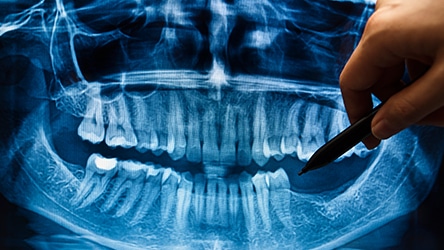New Technique Aims to Simplify Dental Bone Graft Procedures
Journal of Oral Implantology – In dentistry, bone grafts are performed after tooth extraction to preserve the integrity of the jawbone. It is a common issue that, when performing a bone graft, the graft material will lose its shape during the suturing of the soft tissue. This complication can be prevented with the use of “tenting” screws or tacks to help keep the graft in place; however, removal of the screws or tacks requires a second retrievable surgery. To avoid additional surgeries and increased treatment costs, researchers have introduced a new surgical technique for closing the grafted area.

Researchers from the University of Minnesota, Minneapolis, along with the Implant Cosmetic Dental Center in Silver Spring, MD, have introduced a technique that aims to maintain the integrity of the graft during closure. Termed the Continuous Periosteal Strapping Suture (CPSS) technique, this method uses resorbable sutures and membrane, materials that can be resorbed and assimilated into the body. If implemented correctly, CPSS requires a less complex surgical procedure than currently available techniques. This simpler procedure leads to lower overall treatment costs.
The technique used by the researchers relies on resorbable sutures and membrane and does not include any surgical screws or tacks to help keep the graft in place. Instead, a series of intricate knots made with resorbable sutures surrounding the membrane are used. The knots help to maintain the strength of the sutures, creating a firmer hold on the wound closure area.
With the use of resorbable materials, the need for a separate surgery to remove “tenting” screws or tacks can be eliminated. The researchers also found that using sutures with a higher tension rate, or tensile strength, increased the duration of the suture time from 56-70 days to 91-119 days. This increased tensile strength for a longer period is expected to be a critical part of membrane and graft stabilization, because having longer-lasting sutures will help ensure the sustainability of the procedure.
Researcher Gregori M. Kurtzman, DDS, has noted, “One of the biggest challenges when osseous grafting the ridge to widen the site with particulate material is containing the graft and avoiding lateral displacement during healing. The CPSS technique predictably helps contain the graft without the need for an increase in material costs or complicated techniques.”
The researchers conclude that although their technique is limited by the tensile strength and resorption rate of the specific suture used, they still found it to have fewer complications and predictable outcomes. The authors also suggest that future studies should be conducted comparing the CPSS technique with other membrane fixation techniques (i.e. “tenting” screw or tack techniques).
Full text of the article, “Continuous Periosteal Strapping Sutures for Stabilization of Osseous Grafts with Resorbable Membranes for Buccal Ridge Augmentation: A Technique Report,” Journal of Oral Implantology, Vol. 43, No. 4, 2017, is available at: http://joionline.org/doi/full/10.1563/aaid-joi-D-17-00060


